NRL | Stats That Matter: Completion Rate
Last updated: Apr 14, 2020, 2:36AM | Published: Apr 13, 2020, 11:16PM
"Possession is nine-tenths of the law."
It's an expression meaning that ownership is easier to maintain if one has possession of something, or difficult to enforce if one does not.
The old adage came 300 years before rugby league kicked off, and while it isn't literally true, the idea aligns fairly well with our great game.
You play the game to win and you win by scoring more points than the opposition. You're in a much better position to score with the football than you are without it.
In Part 1 of this series, we highlighted that ranking anywhere outside the top three in running metres made and running metres conceded makes winning the premiership a lot more difficult.
WANT MORE NRL CONTENT? Join the free mailing list to get the best content delivered straight to your inbox.
To make those all-important metres and run-up the scoreboard, you need the ball in your hands.
The Melbourne Storm have played with the best completion rate in the competition across the last seven seasons at 78.4% scoring 22.9 points per game (2nd). They've made the finals every season, claimed three minor premierships, played in three Grand Finals, and lifted the Provan-Summons Trophy once in that span.
Expertly coached to have a focus on minimising errors and playing within their structure and shape, they're the most consistent team of the last decade.
So, that settles it: completion rate is the key.
Next.
Not so fast...
The Sydney Roosters have missed the finals once since 2013, but have won four minor premierships, played in three Grand Finals, and won the lot of them. They've done that by scoring the most points at 23.2 per game while playing with the worst completion rate of all 16 teams at 73.8%.
While the high-completion 2017 Storm was one of the best-attacking teams we've ever seen, the high-error 2019 Roosters isn't far behind.
So the two best teams over the last seven seasons are at the bookend of completion rate statistics since 2013.
The Storm have consistently played with a completion rate above the NRL average while the Roosters haven't hit the average in any of the last seven seasons. Nonetheless, they're the two best teams in the competition and set the bar in points per game almost every year.
It raises questions over the classic half-time trope of "completing sets and getting to the kick," which comes up regardless of whether or not they're leading or trailing as the microphone is stuffed in their face.
Sure, completing sets is important. We've already touched on it: possession is nine-tenths of the law. Completing sets doesn't necessarily translate into points on the field, or on the competition ladder, though.
The Canterbury-Bankstown Bulldogs played with the same 80% completion rate as the Storm in 2019. The Dogs got to their kick just as many times as the Storm - 21.42 per game (3rd) vs 21.59 per game (2nd) - but scored just 13.58 points per game (16th). It was much of the same in 2018 with the Bulldogs leading the competition in completion rate at 80% while getting to their kick 18.6 times per game (4th)for just 17.83 points per game (13th).
Rather than "getting to the kick" and all of that halfback speak we hear, Trent Robinson's claim that you "need to play some footy" is what separates the good teams from the bad.
"If you're not playing footy, you are not going to the races".
Robinson's Roosters certainly went to the races in 2019.
Despite only completing 75% of their sets (13th) due to 11.56 errors per game (14th), the Roosters led the competition in points per game at 25.37 per game while also scoring the most per tackle inside the opposition 20 at 1.060 points per tackle. Their high-risk style built on surging through the middle behind 1,663.15 running metres (1st) and 131.07 supports per game (3rd) paid dividends.
So too did having Cooper Cronk direct traffic.
Led by another legend of the game, the Storm had a decent run too.
Another Craig Bellamy inspired season ended with the Storm leading the competition in completion rate at 80%, scoring 25.37 points per game (2nd) and 0.853 points per tackle inside the opposition 20-metre line (3rd). While not the high-powered attack of the Roosters, you can play with a little more patience and control knowing the points will come when you have a maestro in Cameron Smith touching the ball 116 times per game from dummy half.
Completing at 75% (13th) with 11.54 errors (4th) and 12.69 offloads (1st) per game, the Eels run a similarly high-risk attack to the Roosters but without the polish of back-to-back premiers. Only the Roosters ran for more metres than the Eels' 1,646.69 per game in 2019 with their 0.857 points per tackle inside the opposition 20-metre line ranking second in the NRL.
Not every team can finish Robinson's race on the podium, though.
We've touched on the Bulldogs in 2019 already. They were alongside the Storm with an 80% completion rate, but did very little with the ball to score just 13.58 points per game (16th) at 0.509 points per tackle inside the opposition 20-metre line (15th).
The only team to perform worse in scoring efficiency were the Panthers.
They were at the opposite end of the completion rate list.
Despite playing with the worst completion rate in the competition at 73% and being tackled an NRL-high 853 times in the opposition 20, the Panthers scored just 0.484 points per tackle. They had as many chances to score in good ball sets as you could ask for, but their tennis rally-style side-to-side attack based around the most decoy's in the competition at 59 per game became easy to defend. So easy that no team drew fewer penalties inside the opposition 20 than the Panthers.
So, we've said all of that to say this: completion rates matter, but not as much as most people are led to believe.
Just last season, the two best teams in regards to completion rate finished 2nd and 16th in points per game and 3rd and 15th in points per tackle inside the opposition 20. Two of the worst teams in completion rate, on the other hand, finished 1st and 13th in points per game and 1st and 16th in points per tackle inside the opposition.
We know running metres translates into success. But as we've seen in the inconsistencies over the last seven seasons, high completion rates don't offer the same assurances.
Does a strong defence?
Next up in the series we're looking at how teams defend those running metres and completed sets while asking, does defence really win premierships?
ALSO READ: NRL | Stats That Matter: Running Metres
Did you enjoy this article? Join our free mailing list to get the best content delivered straight to your inbox, or join the conversation by leaving a comment below or on the Stats Insider Twitter or Facebook page.




